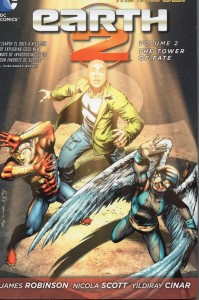Comic Book Review: Earth 2, Vol. 2: The Tower of Fate by James Robinson & Nicola Scott
Disclaimer: I received this book in a Goodreads giveaway on the premise that I would review it.
Some background first, for our younger readers. Back in the 1940s, National Comics (which would become DC) decided to promote some of their lesser-known characters by putting them in a group, the Justice Society of America. These characters would have a meeting, split up into separate stories, then band together at the end to face a common menace. This was the first full-fledged superhero team. Eventually, as page counts lessened, the team started working together through the entire story. And when the superhero fad faded, the comic book they were in switched to Western tales.
Superheroes came back in a big way after the Comics Code was created, and DC created new versions of many of their Golden Age characters. Then a writer got the bright idea of teaming up the then current Flash, Barry Allen, with his Golden Age counterpart, Jay Garrick. He came up with the notion that the earlier stories had happened on an alternate Earth, Earth-2. This allowed the Justice Society and all the other Golden Age characters to be used as having aged semi-realistically from the 1940s to the 1960s. Various series featured the Earth-2 characters having their own adventures. Plus, many other alternate Earths were made up to feature different characters.
In the 1980s, DC’s Powers that Were decided they wanted to “modernize” some of their characters, and streamline the DC Multiverse into one semi-consistent DC Universe, as some writers found the multiple Earths idea “too confusing.” So Crisis on Infinite Earths happened, and now there was just one Earth, with many of the Golden Age characters having fought crime in the 1940s, and others having their history changed to match the new timeline.
And that worked for a while. It took some doing for the Justice Society to find its feet, with several attempts at sidelining them, and drastic roster changes. But they endured, and finally got a popular, relatively long lasting series. However, going into the Twenty-First Century, it was getting increasingly difficult to justify people in their eighties and nineties still actively fighting crime without invoking immortality. You could fudge ages on some characters, but the Justice Society was specifically tied to World War Two.
This, and other issues including the desire to “modernize” characters again, caused the Powers that Be at DC to reboot their line once again in the Flashpoint event. Now superheroes as such had mostly started their careers “five years ago” and were young and “relevant” again. Most of the Golden Age characters had vanished entirely in the New 52, but others hadn’t. Eventually, this was explained with the publication of the new Earth 2 series.
DC has gone back to multiple Earths, and is using this series to depict a timeline where the Golden Age characters are reimagined for a new generation. This Earth was invaded by the forces of Darkseid, and drove them off at the cost of the death, disappearance or disgrace of all their existing heroes. Some years later, new “wonders” are appearing or being revealed as new threats emerge. This volume covers issues 7-12, and a couple of specials that fill in details.
Modern decompressed storytelling means that you don’t get your team together in the first issue and go from there. Indeed, by the sixth issue, some of our heroes had met and briefly worked together to stop a menace, but immediately split up again. The primary storyline in these issues is Flash helping the new Doctor Fate find the resolve to become that character. The primary villain they face is Wotan, who is given a new origin story (including an explanation for the green skin which explains why Wotan hates Doctor Fate’s mentor Nabu so much.)
Meanwhile, Green Lantern and Hawkgirl investigate the death of GL’s fiance, as it turns out the baddies might not have been after GL after all. This doesn’t really get far before Green Lantern is called in to help with Wotan. Elsewhere, Darkseid’s lieutenant Steppenwolf and his pawn Fury (supposed Wonder Woman’s daughter) take over a country. Minor characters have their own subplots.
Good stuff: With this reboot, DC has the freedom to make the cast more diverse from the start, and they’ve done so. After some rough patches in the early issues, most of the heroes are now acting heroic, particularly Flash. The art is decent, and the war against Darkseid’s forces stands in for World War Two nicely.
Not so good: Did we really need to kill the Amazons again? Seriously, we worry about you, DC. Also, there’s a lot of grimness and gritting teeth. I’d like to see a little more fun and people enjoying their powers and abilities. The current DC hatred of marriage also is felt here, killing off spouses and potential spouses to free up the characters for other romantic subplots (or in the case of the gay guy, avoiding that yucky actually having him date thing.)
I can see where DC is coming from, but as an old fogy myself, I miss having heroes who have been around for decades and learned wisdom the hard way.

